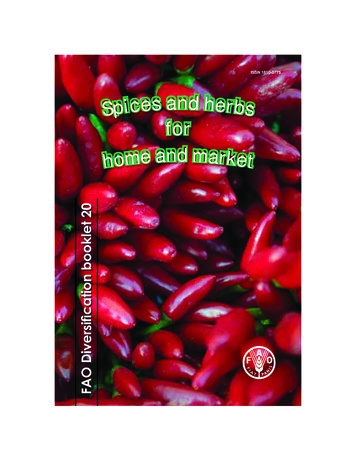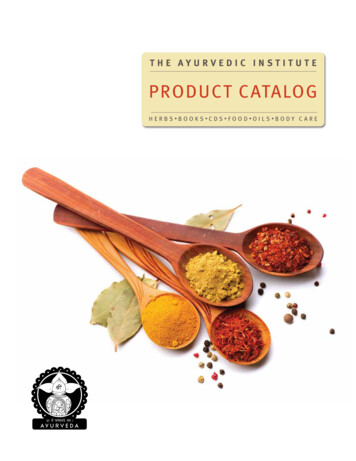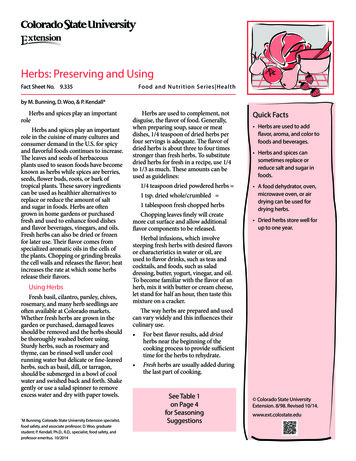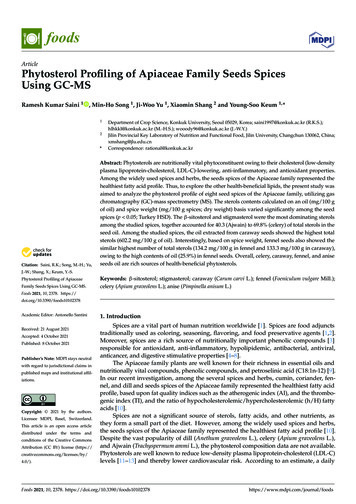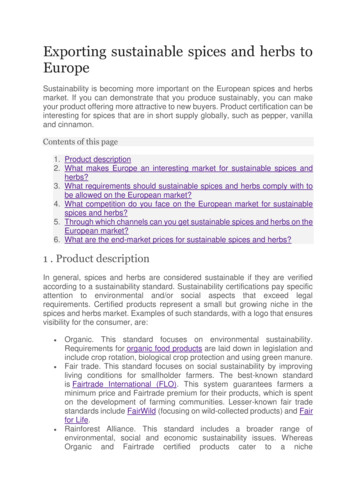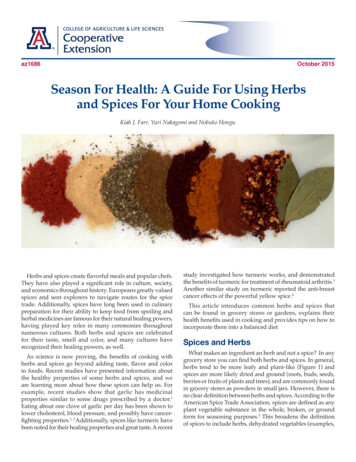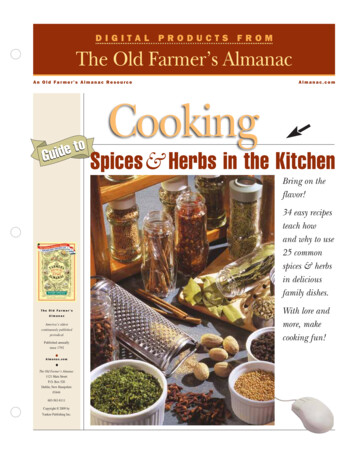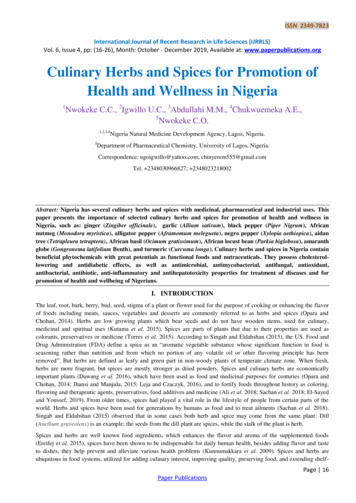
Transcription
ISSN 2349-7823International Journal of Recent Research in Life Sciences (IJRRLS)Vol. 6, Issue 4, pp: (16-26), Month: October - December 2019, Available at: www.paperpublications.orgCulinary Herbs and Spices for Promotion ofHealth and Wellness in Nigeria1Nwokeke C.C., 2Igwillo U.C., 3Abdullahi M.M., 4Chukwuemeka A.E.,5Nwokeke C.O.1,2,3,4Nigeria Natural Medicine Development Agency, Lagos, Nigeria.5Department of Pharmaceutical Chemistry, University of Lagos, Nigeria.Correspondence: ugoigwillo@yahoo.com; chinyerem555@gmail.comTel. 2348030966827; 2348023218002Abstract: Nigeria has several culinary herbs and spices with medicinal, pharmaceutical and industrial uses. Thispaper presents the importance of selected culinary herbs and spices for promotion of health and wellness inNigeria, such as: ginger (Zingiber officinale), garlic (Allium sativum), black pepper (Piper Nigrum), Africannutmeg (Monodora myristica), alligator pepper (Aframomum melegueta), negro pepper (Xylopia aethiopica), aidantree (Tetrapleura tetraptera), African basil (Ocimum gratissimum), African locust bean (Parkia biglobosa), amaranthglobe (Gongronema latifolium Benth), and turmeric (Curcuma longa). Culinary herbs and spices in Nigeria containbeneficial phytochemicals with great potentials as functional foods and nutraceuticals. They possess cholesterollowering and antidiabetic effects, as well as antimicrobial, antimycobacterial, antifungal, antioxidant,antibacterial, antibiotic, anti-inflammatory and antihepatotoxicity properties for treatment of diseases and forpromotion of health and wellbeing of Nigerians.I. INTRODUCTIONThe leaf, root, bark, berry, bud, seed, stigma of a plant or flower used for the purpose of cooking or enhancing the flavorof foods including meats, sauces, vegetables and desserts are commonly referred to as herbs and spices (Opara andChohan, 2014). Herbs are low growing plants which bear seeds and do not have wooden stems, used for culinary,medicinal and spiritual uses (Kutama et al. 2015). Spices are parts of plants that due to their properties are used ascolorants, preservatives or medicine (Torres et al. 2015). According to Singab and Eldahshan (2015), the US. Food andDrug Administration (FDA) define a spice as an “aromatic vegetable substance whose significant function in food isseasoning rather than nutrition and from which no portion of any volatile oil or other flavoring principle has beenremoved”. But herbs are defined as leafy and green part in non-woody plants of temperate climate zone. When fresh,herbs are more fragrant, but spices are mostly stronger as dried powders. Spices and culinary herbs are economicallyimportant plants (Dawang et al. 2016), which have been used as food and medicinal purposes for centuries (Opara andChohan, 2014; Jhansi and Manjula, 2015; Leja and Czaczyk, 2016), and to fortify foods throughout history as coloring,flavoring and therapeutic agents, preservatives, food additives and medicine (Ali et al. 2018; Sachan et al. 2018; El-Sayedand Youssef, 2019). From older times, spices had played a vital role in the lifestyle of people from certain parts of theworld. Herbs and spices have been used for generations by humans as food and to treat ailments (Sachan et al. 2018).Singab and Eldahshan (2015) observed that in some cases both herb and spice may come from the same plant: Dill(Anethum graveolens) is an example; the seeds from the dill plant are spices, while the stalk of the plant is herb.Spices and herbs are well known food ingredients, which enhances the flavor and aroma of the supplemented foods(Ereifej et al. 2015), spices have been shown to be indispensable for daily human health, besides adding flavor and tasteto dishes, they help prevent and alleviate various health problems (Kunnumakkara et al. 2009). Spices and herbs areubiquitous in food systems, utilized for adding culinary interest, improving quality, preserving food, and extending shelf-Page 16Paper Publications
ISSN 2349-7823International Journal of Recent Research in Life Sciences (IJRRLS)Vol. 6, Issue 4, pp: (16-26), Month: October - December 2019, Available at: www.paperpublications.orglife (Duncan et al. 2017). All processed spices have shelf lives. Flavour is maximized by storing a spice whole andgrinding when needed. A whole dried spice has the longest shelf life, so it can be purchased and stored in larger amounts,making it cheaper on a per-serving basis. The shelf life of a whole spice is roughly two years; of a ground spice roughlysix months (Olife et al. 2013). Spices are generally regarded as fresh or dried seeds, fruits or vegetative substanceprimarily used for flavouring, colouring or preserving food. They are available in several forms: fresh, whole dried, orpre-ground dried and usually aromatic and pungent (Achinewu et al. 1995; Olife et al. 2013). Spices not only add flavorand taste to food, but also exhibit tremendous health benefits (Kunnumakkara et al. 2018). Culinary herbs and spices andcan be used for edible purposes (in cooking food, soups, stew, salads and drinks) or medicinally in the treatment ofvarious ailments (Dawang et al. 2016). Herbs and spices are integral part of daily diet (Mann, 2011). There are severalmedicinal uses of spices in our daily life, many spices are used in kitchen and have certain medicinal activity likepurgative, laxative, expectorant, carminative, diuretic etc. Since ancient time and till today spices are used for manypurposes medicinally (Sachan et al. 2018). Spices, as part of diets, have holistic effects on human health (Sachan et al.2018). Generally, a good number of herbs and spices have been found to possess antimicrobial properties (Billing andSherman, 1998; Souza et al. 2005; Muluye et al. 2014; Ereifej et al. 2015; Torres et al. 2015), antimycobacterialpotentials (Neha et al. 2017), antifungal effects (El-Mougy and Abdel-Kader, 2007), cholesterol lowering and antidiabetic effects (Kwada and Tella, 2009), antioxidant and antibacterial properties (Eleyinmi, 2007; Nikousaleh andPrakash, 2008; Kochhar, 2008; Torres et al. 2015; Nugboon and Intarapichet, 2015; Słowianek and Leszczyńska, 2016),antibiotic properties (Edim et al. 2012), anti-inflammatory properties (Thomson et al. 2002; Kochhar, 2008; Muluye et al.2014). Other properties of spices include: modulation of detoxification enzymes and modulation of steroid metabolism(Kochhar, 2008). The antioxidant, antimicrobial and anticancer components present in herbs could enable them toenhance the health and medical status of human being (Singab and Eldahshan, 2015; El-Sayed and Youssef, 2019). Theneed for new therapeutic agents is pertinent and spices are considered as promising agents (Rios and Recio, 2005).According to Olife et al. (2013), majority of Nigerian spices are found in the southern rainforest zone of the country,while others such as garlic (Allium sativum) and ginger (Zingiber officinale) are predominant in the northern zone. Nigeriahas several indigenous spices namely: Allium cepa Linn and A. Sativum Linn, Anona senegalensis Pers, Capiscum annumL and C. frutescens L, Cymbopogon citratus L, Gnetum africanum, Gongronema latifolium, Ocimum gratissimum Linn,Parkia biglobosa Linn, Xylopia aethiopica, among others. Nigerian farmers cultivate spices such as curry (Murrayakoenigii), (Ocimum basilicum), (Ocimum gratissimum), ginger (Zingiber officinale), Ethiopian/guinea/negro pepper(Xylopia aethiopica), black pepper (Piper guineense) and turmeric (Curcuma longa). Similarly, Muhammad and Amusa,(2005) listed some common examples of culinary herbs and spices in Nigeria such as: nutmeg (Myristica fragans), pepper(Piper nigrum), clove (Eugenia caryophyllata), mustard (Brassica juncea), garlic (Allium sativum), onion (Allium cepa),curry (Ocimum canum), ginger (Zingiber officinale), and cinnamon (Cinnamomum burmannil).Nigerian culinary herbs and spices have shown high potential as functional ingredients in traditional snacks (Mann, 2011),and for becoming international commodities as pharmaceutical raw material due to their inherent health benefits and thebioactive compounds found in them. Extracts of these plants could be sources of important molecules that could be usedto produce nutraceuticals (Egharevba and Gamaniel, 2017). The potentials of herbs and spices as functional food andnutraceuticals is generating renewed interest among researchers across the globe due to increasing knowledge andcuriosity about their health benefits (Egharevba and Gamaniel, 2017). Culinary herbs and spices have been applied inseveral industries for the promotion of health and wellbeing of individuals, such as: medicine, food industry, cosmetologyand pharmacy (Leja and Czaczyk, 2016), and pharmaceutical industries (Egharevba and Gamaniel, 2017). Olife et al.(2013) listed 23 spices processors and marketers in Nigeria, with 11 imported spice brands in Nigeria. Egharevba andGamaniel (2017) reported that drugs such as Niprisan, Niprisan plus, Niprimune and Niprimal contain substances used asherbs or spices. Despite these potentials, culinary herbs and spices are largely underutilized in Nigeria with a dearth ofinformation on their cultivation and uses. Although indigenous people developed different methods for collecting,processing, using and conserving culinary herbs and spices in Nigeria, Nwinuka et al. (2005) observed some levels oftoxicants (anti-nutrients) in some spices. Hence, Olife et al. (2013) suggested the following strategies for optimalexploitation and utilization of spices in Nigeria: (i). protection and maintenance of wild grooves. (ii). domestication andcultivation of wild spices. (iii). discouraging over exploitation of wild species and bush burning. (iv). establishment ofresearch and market gardens. (v). organization of spice farmers into cooperatives. (vi). supply of improved spice varietiesto farmers. (vii). establishment of processing clusters. (viii). maintenance of standards. (ix). funding of research anddevelopment. Table 1 shows some common culinary herbs and spices in Nigeria.Page 17Paper Publications
ISSN 2349-7823International Journal of Recent Research in Life Sciences (IJRRLS)Vol. 6, Issue 4, pp: (16-26), Month: October - December 2019, Available at: www.paperpublications.orgTable 1: Common Nigerian culinary herbs and spicesCommon nameScientific nameHausa nameIgbo nameYoruba nameScent leaf (Basil),Tea bushOcimum basilicum,Ocimum gratissimumDaldoya, DoddoyaNchanwuEfirinGingerZingiber officinaleCittaJinjaAtaile, Ataile pupaSmall chili pepperCapsicum annumBorkwono/ twassiOsenkiriAtaweweBird chiliesCapsicum frutescensBorkwonoOseTatase AtarodoCurry leafOcimum canumDoodayaNchanwuEfirinosoAlligator pepperAframomum meleguetaKaninfariOseojiAtareEthiopian pepperXylopia aethiopicaKimbaUdaEeruBlack pepperPiper nigrumMosoro, MasoraUzizaIyereLocust beanParkia clappertonianaDawadawaOgiri-igalaIru, TokoroGarlicAllium sativumTafarnuwaGalikiAayuOnionsAllium cepaAlibasa, AlbasaYabasi, ayoAlubosaPepper fruitDennettia tripetalaDaniyaMmimiAta igbereAfrican nutmegMonodora myristicaGujiya dan miya,Gyadar kamshiEhuruEhir, Abo lakosheAmaranth globe,Bush buck, Tafel boomGongronema latifolium-UtaziMadumaro, ArokekeAidanTetrapleura TetrapteraDawaUzaguza, OshoshoAridenTurmericCurcuma longaKurkur, gangamauJinja uheAtaile pupaPepper mintMentha piperitaNa‟a na‟a- Pepper mintEweNa‟a na‟aPepper fruitDennettia tripetalaDaniyaMmimiAta igbereCloveSyzgium la foenumKimbaFenugrikEruFigure 1 shows some selected culinary herbs and spices in Nigeria.Fig. 1. Some selected culinary herbs and spices in Nigeria.Source: Ali et al. (2018).Page 18Paper Publications
ISSN 2349-7823International Journal of Recent Research in Life Sciences (IJRRLS)Vol. 6, Issue 4, pp: (16-26), Month: October - December 2019, Available at: www.paperpublications.orgTable 2 shows spice plant classifications and major active components.Table 2. Spice plants classification and main active principles of the spicesSource: El-Mougy and Abdel-Kader (2007).The functional and nutraceutical components in common herbs and spices and their health benefits are shown in Table 3.Table 3. Common and nutraceutical components of common herbs and spices.Source: Jhansi and Manjula (2016).Page 19Paper Publications
ISSN 2349-7823International Journal of Recent Research in Life Sciences (IJRRLS)Vol. 6, Issue 4, pp: (16-26), Month: October - December 2019, Available at: www.paperpublications.orgTable 4 shows antioxidant compounds isolated from selected herbs and spices.Table 4. Antioxidants isolated from selected herbs and spices.Source: Leja and Czaczyk, (2016).II. BENEFITS OF SELECTED CULINARY HERBS AND SPICES IN NIGERIA1.Ginger (Zingiber officinale)Ginger is a herb whose rhizome is widely used as a medicine, or as a spice in cooking throughout the world and especiallyused in kitchen (Sachan et al. 2018). In the Nigerian market, ginger is well known and on high demand even though it isquite expensive. Kaduna state is the highest producer of the crop, Gombe, Bauchi, Benue and Nassarawa states amongothers are also major producers of the crop. Ginger is widely used throughout the world for treating loss of appetite,nausea and vomiting after surgery, nausea resulting from cancer, flatulence, stomach upset and morning sickness. Somepeople find ginger helpful in relieving the symptoms of upper respiratory tract infection, bronchitis, cough, menstrualcramps and muscle pain. Phytochemical constituents of the plants include saponins, tannins, anthraquinones, glycosides(Ajayi et al., 2013). Ginger has been reported to have antibacterial (Abitogun and Badejo, 2010), antioxidant (Azeez etal., 2012), anti-inflammatory and anti-ulcerogenic (Anosike et al., 2009) properties.Page 20Paper Publications
ISSN 2349-7823International Journal of Recent Research in Life Sciences (IJRRLS)Vol. 6, Issue 4, pp: (16-26), Month: October - December 2019, Available at: www.paperpublications.org2.Garlic (Allium sativum)The consumption of garlic has the potential to reduce arterial plaque and possess antioxidant properties on skin cancer(Das and Saha, 2008), alongside antimicrobial properties (Olusanmi and Amadi, 2010). This spice has also been used infolk medicine for diabetes and inflammation treatment (Sachan et al. 2018). According to Thomson et al., (2002), theconsumption of ginger led to reduction in blood cholesterol and also served as a potential anti-inflammatory andantithrombotic agent. The crop has been known to have several food and medicinal uses. It is used for preserving meatand meat products, used as spices in salad and for seasoning of vegetables. Garlic extracts are used in curing whoopingcough, lung diseases, and stomach pain and child birth disorder. The extract could be used against ear-ache, hypertension,eye sores, an antidote against poisons as well as antibacterial. Garlic could also be used as an insecticide and could alsoreduce cholesterol level in human blood (Hamma et al., 2013). Phytochemical constituents of the plant include alkaloids,glycosides, saponins, flavonoids, steroids, proteins, carbohydrates, oils, reducing sugars and acidic compounds (Amehand Nwammoh, 2010).3.Black Pepper (Piper Nigrum)Black pepper is used for nearly all soups and all other foods especially in Eastern parts of Nigeria. The leaves and seedsof this flowering vine are used for the special taste, flavor and aroma they add to soups, stews, sauces, vegetable dishes,salads, and other dishes. Black pepper is the world‟s most traded spice. In Nigeria, sometimes, black pepper leaves arepreserved by sun-drying while the ripe seeds are ground and bottled for use. Black pepper is mostly used for its dietarysource of Vitamin C, Vitamin K and manganese other than as culinary. It has a long history of medicinal benefits withantioxidant (Gulcin, 2005), anti-microbial (Dorman and Deans, 2000), and anti-mutagenic properties (El-Hamss et al.,2003). It prevents for cold and catarrh, helps to improve appetite and digestion, promotes sweating and urination.Phytochemical constituents include alkaloids, flavonoids, essential oil, terpenoids (Gupta et al., 2013). Nwose (2009)reported the importance of pepper as antioxidant nutrition therapy used to treat cardiovascular diseases, diabetes, erectiledysfunction and respiratory diseases. Another variety of black pepper known as African black pepper (Piper guineense) isa West African spice plant with medicinal property and widely used traditionally in the treatment of various ailments(Besong et al. 2016). The phytochemical studies of the plant revealed the presence of proteins, carbohydrates, alkaloids,steroids, glycosides, saponins, flavonoids, tannins and phenolic compounds. It also contains vitamins, minerals and fat.Various studies have been done on the plant to determine its pharmacological and therapeutic properties such asantibacterial, antioxidant, anti-inflammatory, hepatoprotective, fertility, aphrodisiac, anticonvulsant and larvicidalproperties.4.African Nutmeg (Monodora myristica)African nutmeg, also known as calabash nutmeg, grows naturally in evergreen forests from Liberia, Nigeria, Cameroon,to Uganda and Kenya. African nutmeg is cultivated mainly in the Southern parts of Nigeria. The seeds are economicallyand medicinally important and the kernel obtained from the seed is a popular condiment used as a spicing agent in bothAfrican and continental cuisines in Nigeria (Okafor, 1997). Reports on the phytochemical screening of the seeds of thisplant revealed the presence of flavonoids, glycosides, saponins, cyanogenic glycosides, tannins, steroids, oxalates andphytates (Ekeanyanwu et al., 2010). Like other Nigerian spices, African nutmeg is said to be highly endowed withmedicinal properties. The root is chewed to relieve toothache and arthritis while the seed is used to relieve anaemia,hemorrhoids, erectile dysfunction and more. The seed is used locally in the treatment of cough, headache, fever, skindiseases and when ground to powder, helps relieve constipation and control passive uterine hemorrhage in womenimmediately after child birth (Kigigha and Enebi, 2012). Nutmeg essential oil possesses an excellent anti-carcinogenicprotecting activity (Singab and Eldahshan, 2015). The antibacterial effect of the oily seed extracts of African nutmeg hasbeen reported (Udoh et al., 2004), and the alcoholic extracts of the seed showed the ability to reverse the toxigenic effectsof aflatoxin (Oluwafemi and Taiwo, 2009). African nutmeg is used to flavor and thicken dishes and it is also a substitutefor nutmeg. Traditionally, it is ground or grated and used as a seasoning. The spice is usually fried and ground and usedfor preparing „native salad‟ (ugba, and abacha) in the southeastern part of Nigeria. In northern Nigeria, this spice is driedand ground, and then used as seasoning for virtually all sorts of dishes. The powdered form of African nutmeg is found innorthern Nigeria where it is used in meat dishes including suya and different stews as well as pepper soups. Nutmeg isused to treat complaints of the digestive tract, such as stomach cramps and diarrhea, as well as catarrh of the respiratorytract (Mann, 2011).Page 21Paper Publications
ISSN 2349-7823International Journal of Recent Research in Life Sciences (IJRRLS)Vol. 6, Issue 4, pp: (16-26), Month: October - December 2019, Available at: www.paperpublications.org5.Alligator Pepper (Aframomum melegueta)Generally, in Nigeria, the seed of Alligator pepper is used in different formations for nutrition and food purposes. The tinyseeds are extracted from its pods and then grounded and added to soups and stews. This is meant to produce a specialtasty flavor, peppery taste and fruity undertone to the soups. For medicinal uses, those suffering from ailments likearthritis, boils, pimples and inflammatory diseases, chew alligator pepper for relief. Also, it is known for its antiinflammatory properties, antimicrobial properties used in the treatment of related diseases like dental problem, asthma andbody weakness (Echo et al., 2012). The cultivation of this species is difficult and cannot be sustained through naturalregeneration due to seed dormancy caused by hard seed coats. It is, however, convenient and most effective to multiplythis species through seed-based means, but the seeds are tiny and require good nursery techniques (Idu, 2009).Phytochemical constituents include: alkaloids, tannins, saponins, steroids, cardiac glycosides, flavonoids, terpenoids,phenol (Doherty et al., 2010). Reported pharmacological activities include antioxidant, antiglycation (Kazeem et al.,2012), and antimicrobial (Doherty et al., 2010) activities.6.Negro Pepper (Xylopia aethiopica)Negro pepper comes from the tropical West African rain forest tree but its seeds and leaves are widely used in all parts ofNigeria and indeed all over the world as spice and medicine. The spice is aromatic, has an intense flavor and is slightlybitter. The seeds are embedded in pods. In West Africa, the tree can flower and produce two crops of pods a year. Insome food and soups, the pods are opened up and the sticky black seeds are removed and discarded because of theirbitterness. In others, the pods and seeds are toasted over open fire and then crushed. Some of its pharmacologicalproperties have been scientifically established. Some reports show that Negro pepper has blood sugar lowering effects. Itis used for bronchitis, dysentery, painful febrile conditions, and as a laxative. In Eastern Nigeria, where it appears to bemore used than elsewhere in Nigeria, it is the culinary herb of choice for nursing mothers. Negro pepper is used forcooking pepper soups, nsala soup for lactating mothers, as well as several other dishes. In Northern Nigeria, where it iscalled kimba, it is ground and used in seasoning meat and a variety of other dishes.7.Aidan tree (Tetrapleura tetraptera)The Aidan tree, a deciduous perennial native to West Africa, has many uses. It is referred to as apapa in Ijaw, while theBinis call it ighimiaka. The fruit of the Aidan tree has its unique flavor and aroma that spices up white soup (afia afere inEfik or ofe nsala in Igbo). In Ibibio land, it is used in spicing nearly all foods. The Igbo tribe in Nigeria use it mainly forcooking pottage. Ijaw people use it to prepare pepper soups and other dishes. The plant is used as a spice, a medicine andas a dietary supplement rich in vitamins. The stem bark, fruits and pods are used for various medicinal purposes. The podsnotably have an appealing culinary use for mothers from the first day of delivery to post parturition and as lactation aid(Enwere, 1998). The spice is widespread in southern Nigeria where it is used by traditional healers for the managementand treatment of arthritis and other inflammatory related diseases like asthma, diabetes mellitus, hypertension, epilepsy,schistosomiasis etc.8.African Basil (Ocimum gratissimum)This very important culinary herb is widely used all over the world. As an awesome multi-purpose plant, used fresh ordried, African Basil is commonly cultivated for dietary and medicinal uses. Due to its peculiar and pungent aroma,African Basil is known all over Nigeria as scent leaf. Its use as meat seasoning in contemporary Nigeria is almost withoutequal among Nigerian culinary herbs. Others put the leaves in salads. It tastes great in stews. For its taste and strongaroma, the Ijaw from south-southern part of Nigeria use the leaves in sauces, soups, and meat. It is used in the famedekpang nkwukwo soup of the Efik and Ibibio people. It has also been an Igbo plant for ages and tastes great with ofeakwu, ukwa and other Igbo delicacies. The plant serves as a mosquito repellent, and is used for the traditional treatmentof fever, tooth and gum disorders. The pulped foliage is believed to have antiseptic properties. Phytochemicalconstituents include tannins, flavonoids, terpenoids, saponins and alkaloids (Mann, 2012). It has been reported to haveanti-inflammatory, antibacterial, antifungal, anti-carcinogenic and antioxidant properties (Mann, 2012).9.African Locust Bean (Parkia biglobosa)The African locust bean is a commonly used spice throughout the Nigerian lands and regions. Together, the trio of iru,ogiri okpei and dawadawa are used as local seasoning in Nigeria. This indigenous spice is developed from the seedsPage 22Paper Publications
ISSN 2349-7823International Journal of Recent Research in Life Sciences (IJRRLS)Vol. 6, Issue 4, pp: (16-26), Month: October - December 2019, Available at: www.paperpublications.orgwhich are boiled, dried and pounded to form paste and then set aside to ferment for some days. This product is used forseasoning in stew and indigenous soups, the fermented spice is rich in developing antibodies against attack by diseases. Ithas very high protein content and is believed to be very good in improvement of vision, digestion, in addition to otherhealth benefits such as controlling diabetes and cholesterol level.10. Amaranth globe (Gongronema latifolium Benth)G. latifolium is referred to as utazi and madumaro by the Igbo and Yoruba tribes of Nigeria respectively. This plant hasbeen used in the Eastern part of Nigeria, particularly Igbo land, over the ages but has now become a regular feature inNigerian delicacies across the country. The leaves serve as edible vegetables for soups. It is used for the bitter taste itimparts to soups and stews. Its peculiar bitter taste is believed to be its unique antidote for treatment of some stomachrelated ailments and management of other diseases like diabetes and high blood pressure. G. latifolium has a sharp-bitterand sweet taste and is widely used as a leafy vegetable and as a spice for sauces, soups, and salads. The leaves are used asa bitter tonic to treat loss of appetite and for management of diabetes. An infusion of the aerial parts is taken to treatcough, intestinal worms, dysentery, dyspepsia, and malaria. The plant is similarly used in the treatment of hypertension,muscular pains, arthritis, joint inflammation and control of cholesterol. Gongronema latifolium possess antihepatotoxicity effect against liver damage induced by paracetamol (Ozor et al. 2019), anti-ulcer, analgesic and antipyretic properties (Akuodor et al. 2010), with potential food and antibacterial uses (Eleyinmi, 2007). The twig and rootbark extracts may be a good source of medically active phytochemicals and micronutrients relevant in human and animalnutrition (Eneji et al. 2011).11. Turmeric (Curcuma longa)Turmeric gives a natural orange-red or reddish-brown dye and imparts yellow colour to cloth and foods. It is one of theprincipal ingredients of curry, to flavor various foodstuffs (Muhammad and Amusa, 2005). It is a „golden spice‟ whichhas been recognized for its anti-inflammatory, antimicrobial, insecticidal, antimutagenic, radioprotective, and anticancerproperties (Singab and Eldahshan, 2015; Kunnumakkara et al. 2018). Turmeric is considered as a carminative, tonic,blood purifier, vermicide and an antiseptic. It is an essential spice in curry production. It is used as an importantcondiment and as a dye with various applications in drug and cosmetic industries. As a traditional remedy, turmeric hasalso been quite extensively used for centuries to treat various disorders such as rheumatism, body ache, skin problems(e.g. wounds, burns and acne), intestinal worms, diarrhea, intermittent fevers, hepatic diseases, urinary discharges,dyspepsia, inflammations, constipation, leukoderma, amenorrhea, dental diseases, digestive disorders such as dyspepsiaand acidity, indigestion, flatulence, ulcers, and colic inflammatory disorders such as arthritis, colitis and hepatitis(Kunnumakkara et al. 2009).III. ROLE OF NIGERIA NATURAL MEDICINE DEVELOPMENT AGENCY (NNMDA) INDEVELOPMENT OF NATURAL PRODUCTSThe Agency has research and experimental farms at various vegetation regions of Nigeria for cultivation of medicinal,aromatic and pesticidal plants including culinary herbs. The Agency is poised to train individuals interested in cultivationof medicinal plants and herbs for medicinal, culinary and commercial purposes. In addition, the Agency produces anddevelops natural medicines and herbal products with international standard to promote safe and affordable healthcaredelivery system in Nigeria. The Agency has widely conducted ethnobotanical surveys of medicinal and aromatic plants inthe six geopolitical zones of Nigeria, which bring to public knowledge the benefits of medicinal plants and culinary herbs,and for onward biomedical and pharmacological research, herbal drug formulations, production and development. Thefocus has been the identification, documentation and usage of the medicinal and aromatic plants, culinary herbs and spicesfor treatment of diseases and ailments by traditional medicine practitioners (TMPs) and for further research.IV. CONCLUSION AND RECOMMENDATIONThe contribution of spices and culinary herbs in the promotion of health and wellness is enormous with promisingpotentials in the area of food, medicine, industry and pharmaceuticals. The presence of secondary metabolites in spicesand herbs have been a fertile ground for chemical investigation for decades driving the frontiers of chemical knowledgeforward. In recent years, there has been an emphasis on secondary metabolites in relation to dietary components whichmay have a considerable impact on human health. The diverse biological activities exhibited by these spices and herbs canPage 23Paper Publications
ISSN 2349-7823International Journal of Recent Research in Life Sciences (IJRRLS)Vol. 6, Issue 4, pp: (16-26), Month: October - December 2019, Available at: www.paperpublications.orgbe attributed to the presence of a wide array of secondary metabolites so there is need for their continuous availability.However, since most of Nigerian spices grow in the wild, Agro
removed". But herbs are defined as leafy and green part in non-woody plants of temperate climate zone. When fresh, herbs are more fragrant, but spices are mostly stronger as dried powders. Spices and culinary herbs are economically important plants (Dawang et al. 2016), which have been used as food and medicinal purposes for centuries (Opara and
